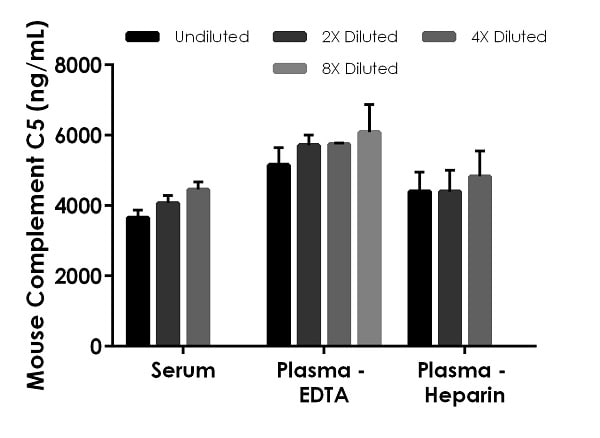Mouse Complement C5 ELISA Kit (ab264609)
Key features and details
- One-wash 90 minute protocol
- Sensitivity: 1.97 ng/ml
- Sample type: Cell culture media, EDTA Plasma, Hep Plasma, Serum
- Detection method: Colorimetric
- Assay type: Sandwich (quantitative)
- Reacts with: Mouse
Overview
-
Product name
Mouse Complement C5 ELISA Kit
See all C5 kits -
Detection method
Colorimetric -
Precision
Intra-assay Sample n Mean SD CV% Protein 8 6.2% Inter-assay Sample n Mean SD CV% Protein 3 4.4% -
Sample type
Serum, Cell culture media, Hep Plasma, EDTA Plasma -
Assay type
Sandwich (quantitative) -
Sensitivity
1.97 ng/ml -
Range
4.69 - 300 -
Recovery
Sample specific recovery Sample type Average % Range Serum 109 105% - 117% Cell culture media 112 110% - 114% Hep Plasma 100 98% - 103% EDTA Plasma 96 90% - 101% -
Assay time
1h 30m -
Assay duration
One step assay -
Species reactivity
Reacts with: Mouse -
Product overview
Mouse Complement C5 ELISA Kit (ab264609) is a single-wash 90 min sandwich ELISA designed for the quantitative measurement of Complement C5 protein in serum, edta plasma, hep plasma, and cell culture media. It uses our proprietary SimpleStep ELISA® technology. Quantitate Mouse Complement C5 with 1.97 ng/ml sensitivity.
SimpleStep ELISA® technology employs capture antibodies conjugated to an affinity tag that is recognized by the monoclonal antibody used to coat our SimpleStep ELISA® plates. This approach to sandwich ELISA allows the formation of the antibody-analyte sandwich complex in a single step, significantly reducing assay time. See the SimpleStep ELISA® protocol summary in the image section for further details. Our SimpleStep ELISA® technology provides several benefits:
- Single-wash protocol reduces assay time to 90 minutes or less
- High sensitivity, specificity and reproducibility from superior antibodies
- Fully validated in biological samples
- 96-wells plate breakable into 12 x 8 wells stripsA 384-well SimpleStep ELISA® microplate (ab203359) is available to use as an alternative to the 96-well microplate provided with SimpleStep ELISA® kits.
-
Notes
Mouse Complement C5 activation by a C5 convertase initiates the spontaneous assembly of the late complement components, C5-C9, into the membrane attack complex. Derived from proteolytic degradation of complement C5, C5 anaphylatoxin is a mediator of local inflammatory process. Binding to the receptor C5AR1 induces a variety of responses including intracellular calcium release, contraction of smooth muscle, increased vascular permeability, and histamine release from mast cells and basophilic leukocytes. C5a is also a potent chemokine which stimulates the locomotion of polymorphonuclear leukocytes and directs their migration toward sites of inflammation. Mouse Complement C5 shares a 64.4%, and 81.8% sequence homology with rat and human, respectively.
-
Platform
Pre-coated microplate (12 x 8 well strips)
Properties
-
Storage instructions
Store at +4°C. Please refer to protocols. -
Components 1 x 96 tests 10X Mouse Complement C5 Capture Antibody 1 x 600µl 10X Wash Buffer PT (ab206977) 1 x 20ml 50X Cell Extraction Enhancer Solution (ab193971) 1 x 1ml Antibody Diluent 5BR 1 x 6ml Denaturant 1 x 500µl Mouse Complement C5 Detector Antibody (Lyophilized) 1 vial Mouse Complement C5 Lyophilized Recombinant Protein 2 vials Plate Seals 1 unit Sample Diluent NS (ab193972) 1 x 50ml SimpleStep Pre-Coated 96-Well Microplate (ab206978) 1 unit Stop Solution 1 x 12ml TMB Development Solution 1 x 12ml -
Research areas
-
Function
Activation of C5 by a C5 convertase initiates the spontaneous assembly of the late complement components, C5-C9, into the membrane attack complex. C5b has a transient binding site for C6. The C5b-C6 complex is the foundation upon which the lytic complex is assembled.
Derived from proteolytic degradation of complement C5, C5 anaphylatoxin is a mediator of local inflammatory process. It induces the contraction of smooth muscle, increases vascular permeability and causes histamine release from mast cells and basophilic leukocytes. C5a also stimulates the locomotion of polymorphonuclear leukocytes (chemokinesis) and direct their migration toward sites of inflammation (chemotaxis). -
Involvement in disease
Defects in C5 are the cause of complement component 5 deficiency (C5D) [MIM:609536]. A rare defect of the complement classical pathway associated with susceptibility to severe recurrent infections, predominantly by Neisseria gonorrhoeae or Neisseria meningitidis.
Note=An association study of C5 haplotypes and genotypes in individuals with chronic hepatitis C virus infection shows that individuals homozygous for the C5_1 haplotype have a significantly higher stage of liver fibrosis than individuals carrying at least 1 other allele (PubMed:15995705). -
Sequence similarities
Contains 1 anaphylatoxin-like domain.
Contains 1 NTR domain. -
Cellular localization
Secreted. - Information by UniProt
-
Alternative names
- Anaphylatoxin C5a analog
- C3 and PZP-like alpha-2-macroglobulin domain-containing protein 4
- C5
see all -
Database links
- Entrez Gene: 15139 Mouse
- SwissProt: P06684 Mouse
- Unigene: 2168 Mouse
Images
-
SimpleStep ELISA technology allows the formation of the antibody-antigen complex in one single step, reducing assay time to 90 minutes. Add samples or standards and antibody mix to wells all at once, incubate, wash, and add your final substrate. See protocol for a detailed step-by-step guide.
-
The Complement C5 standard curve was prepared as described in Section 10. Raw data values are shown in the table. Background-subtracted data values (mean +/- SD) are graphed.
-
The concentrations of Complement C5 were measured in duplicates, interpolated from the Complement C5 standard curves and corrected for sample dilution. Undiluted samples are as follows: serum 3%, plasma (EDTA) 0.75%, and plasma (heparin) 0.38%. The interpolated dilution factor corrected values are plotted (mean +/- SD, n=2). The mean Complement C5 concentration was determined to be 4.06 µg/mL in serum, 5.61 µg /mL in plasma (EDTA) and 4.40 µg /mL in plasma (Heparin).
-
To learn more about the advantages of recombinant antibodies see here.













